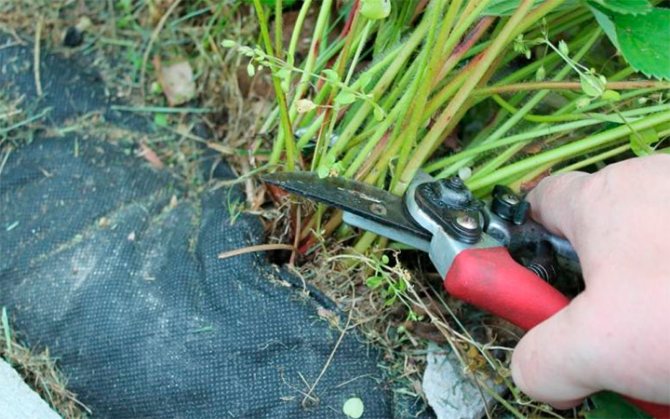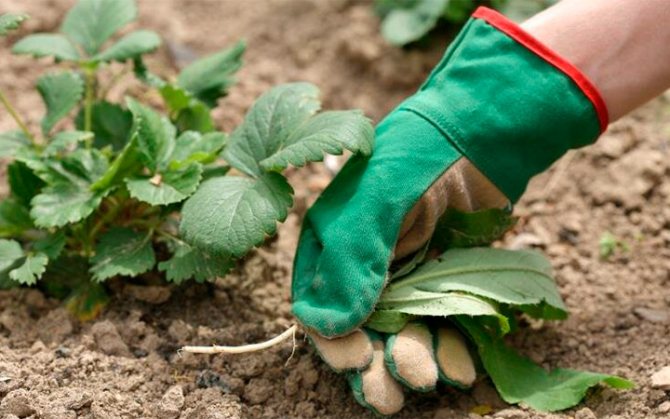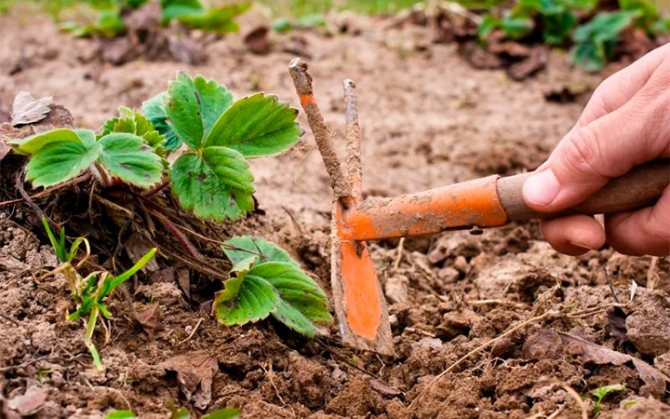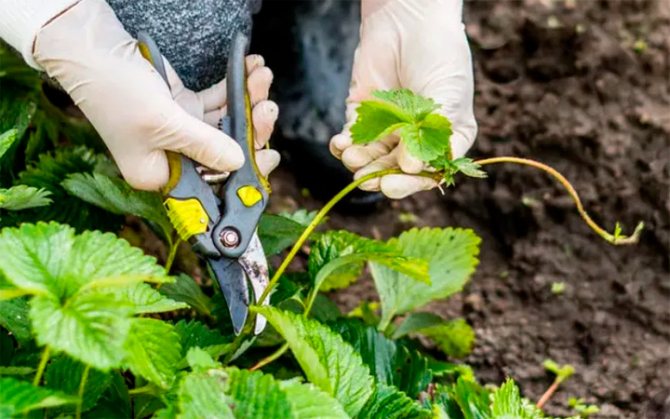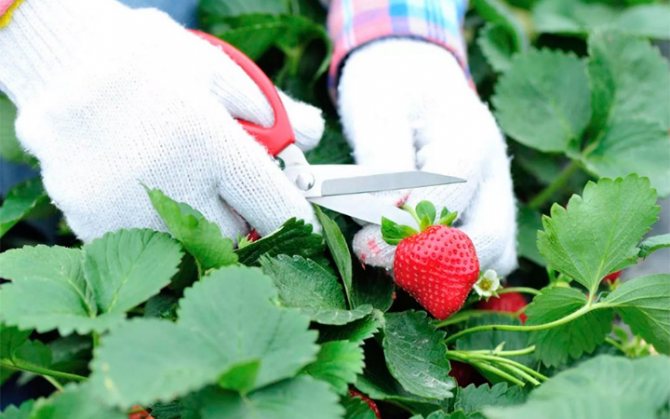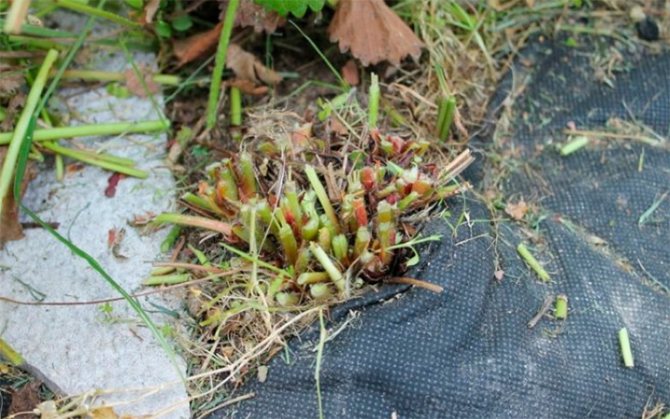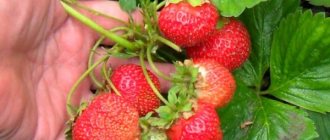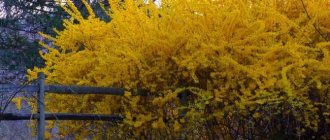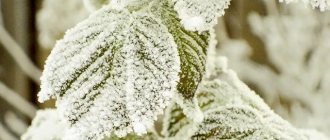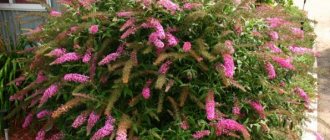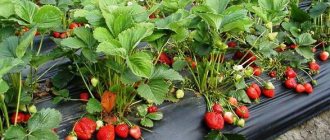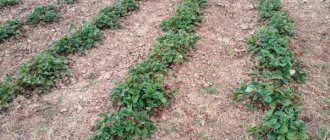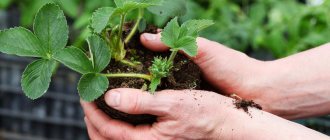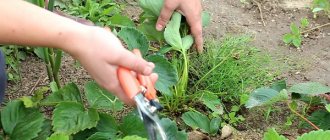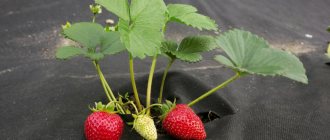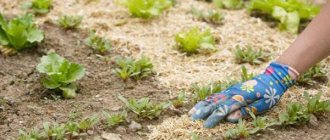Repairing strawberries, or, as it is more correctly called, gardening strawberries, can increasingly be found in garden plots not only for amateurs, but also for professionals. Sometimes it inhabits large territories, and the owners are happy with this coexistence. However, to my surprise, to this day, many have questions about the proper care of the garden strawberry, as if this overseas miracle was brought to our land just a couple of days ago.
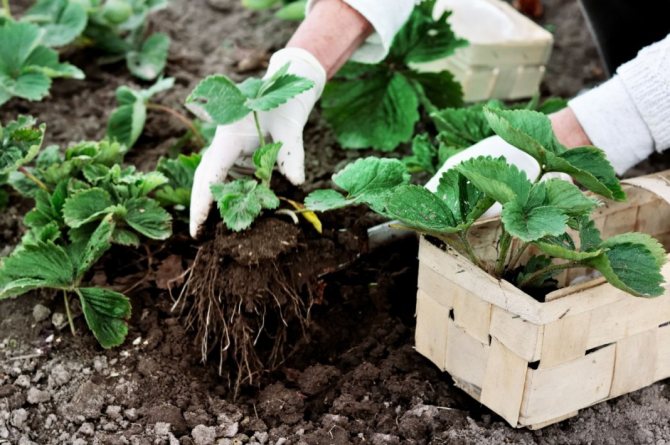
Caring for remontant strawberry bushes. <>
The main difference between remontant garden strawberry and ordinary strawberry is its ability to bloom and, accordingly, bear fruit twice a season, without interruption. Only a small fraction of plants - raspberries and a number of citrus fruits - have this ability.
Garden strawberries of remontant varieties can lay flower buds either under long daylight conditions (for example, the Garland variety), or under neutral daylight conditions (for example, the Miracle of the World variety). It is noteworthy that varieties that are able to lay flower buds in conditions of long daylight hours give about 40% of their harvest in July and up to 60% of their harvest in August.
Garden strawberry repairing, capable of planting flower buds in neutral daylight conditions, blooms and bears fruit throughout the warm period, gradually giving back its harvest. Taking into account the great wear and tear of plants, plantations of remontant strawberries, which bear fruit twice a year, must also be changed once every three years, and those that bear fruit during the entire warm period - once every two years, each time changing the location of the site.
In our material, we will try to bring to your attention the subtleties of caring for the remontant garden strawberry in as much detail as possible.
How to properly care for remontant garden strawberries?
By and large, the varieties of remontant strawberries cannot be called capricious, they are all quite unpretentious, but they still have their own subtleties in care. For example, everyone knows that modern large-fruited varieties of remontant strawberries can form berries weighing from 65 to 90 grams or more. Naturally, this will lead with a high degree of probability to a fairly rapid depletion of the soil and the need for additional fertilization. Perhaps that is why a number of gardeners, contrary to common opinion, are advised to remove the very first spring flower stalks.
Then the second harvest of remontant strawberries, firstly, will be much earlier than the due date, therefore, the plants will prepare for winter without human intervention. Secondly, the berries will be tastier and larger. Sometimes, in total, the total harvest after such a simple technique even exceeds two total harvests or an all-season harvest for remontant varieties of a different type.
Caring for remontant garden strawberries includes strictly mandatory stages - this is an indispensable watering (plants should be provided with plenty of moisture), fertilization (everything is fine here in moderation, but the plants should not suffer from a deficiency of one or another element), loosening of the soil (after each watering and rain to avoid the formation of a soil crust when air and water exchange is disturbed), mulching the beds (after each watering, as it inhibits the growth of weeds and the formation of soil crust), weed control (especially with wheatgrass - the most vicious competitor of crops) , destruction of pests and diseases (at the earliest stages of their manifestation), pruning of bushes (a specific procedure for remontant strawberries) and, finally, preparation for winter (an important stage in the life of remontant garden strawberries).
Important! Gardeners who have gone through fire and water recommend necessarily mulching beds with remontant garden strawberries, because the root system of this berry crop, unlike ordinary garden strawberries, is located high, and the plants very often suffer from a banal lack of moisture. To conserve irrigation water, you need to use the mulch almost immediately after watering (and it is better to water it with water at room temperature and in the evening). Spruce needles, sawdust, straw, humus, hay, ordinary mown grass can be used as mulch. In addition to protecting against moisture loss, mulch will also protect the berries from splashing with soil during rain and watering and inhibit the growth of weeds (do not forget about them!).
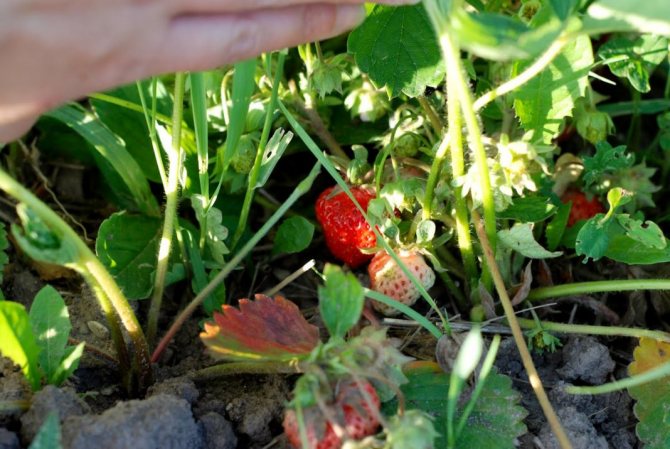

Care of remontant strawberries. <>
Agrotechnical cultivation
All varieties of garden strawberries available today to gardeners and gardeners can be divided into two groups:
Despite serious differences in the mode of their vegetation, the methods of cultivation and care for each of the species are similar in many respects, because, in fact, these plants are the closest relatives. However, in this material we will not talk at all about general features, but on the contrary, about the differences that must be taken into account in order to obtain a solid harvest.
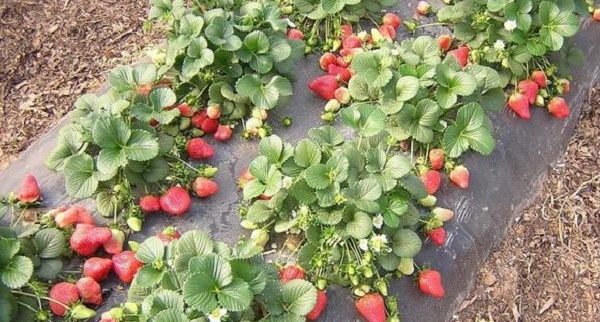

The taste qualities of this berry are in no way inferior to ordinary strawberries, and vice versa, they are often more pleasant.
On average, the number of fruiting remontant berries in one season is equal to two units, however, subject to certain conditions, the harvest can be obtained 3, or even all 4 times. The final amount will depend on when the so-called fruit barrels are laid in plants.
So, an ordinary garden berry, the process of forming the mentioned barrels produces only during that period of the year when daylight hours become short, that is:
- at the end of the summer season;
- at the beginning of autumn.
The repaired plant variety successfully carries out this process:
- during the period of long daylight hours (budding at a temperature of + 15 ° C and the length of daylight hours 14-17 hours);
- in the period of neutral daylight hours (laying the kidneys by periods, every 5-6 weeks at a temperature from +2 to + 30 ° C).
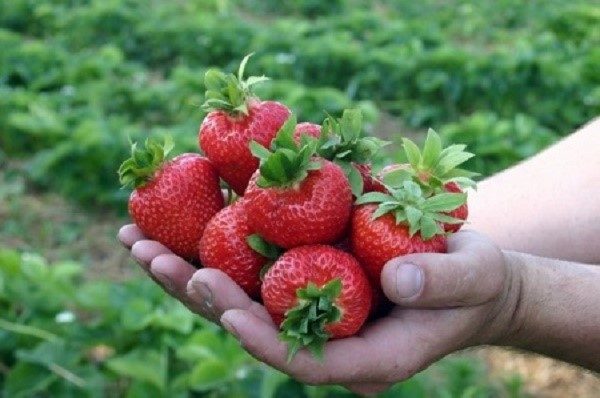

Some fruits can reach 75-100 grams, depending on the variety.
A strawberry of neutral daylight hours must be present in every berry lover, since in the conditions of a "failed" season, which is not so rare due to the severity and unpredictability of climatic conditions in Russia, an ordinary strawberry may not bear fruit, but the mentioned remontant variety with comfort will continue to gain the ovary. And it will continue to do this until the onset of frost.
The second harvest of traditional remontant strawberries is the most abundant, depending on the age of each bush, it can account for up to 90% of the total harvest harvested during the growing season.
Note: unfortunately, remontant strawberries, especially actively bearing fruit in a particular season, may not withstand the load and die off by autumn. You need to know this feature, and be ready to replace obsolete bushes with new ones.
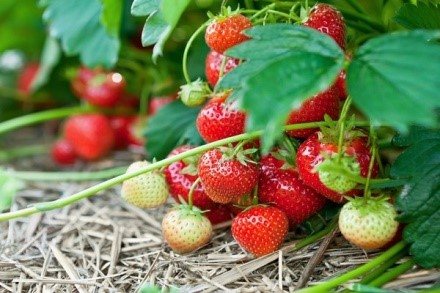

Rapid chopping of berries is a minus of the strawberry variety in question, however, it is more than offset by abundant primary yields
Read also: When to pickle cabbage according to the lunar calendar
Another interesting feature of remontant strawberries is that they can form fruits:
- on maternal plants;
- young rooted mustache.
This is a great opportunity to get more berries than you expected, however, provided that the beds are covered with garden film, the mustache will have to punch the road in the literal sense: making holes in the fabric.
It is not for nothing that the strawberry of the variety we are considering is considered large-fruited. One berry of such a plant can reach 75 grams, record-breaking varieties sometimes delight gardeners with berries weighing 100 grams.
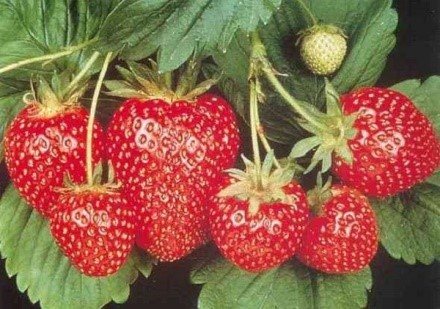

This berry has cultivation features that must be taken into account.
In the following table, we have systematized information about the features of the remontant variety of berries, which should be taken into account when deciding on its cultivation, for readers who are keen on gardening. Let's consider them.
Table 1. Features of growing remontant strawberries
| Nuance | Description |
| Accelerated growth and fruiting cycle | Unfortunately, due to the high load (active fruiting), the strawberries of the considered variety cannot bear fruit for as many years as ordinary strawberries. So, its shorter terms will be:
|
| Harvest sacrifice | Another feature: in order to get the second harvest of remontant berries a little earlier and in a larger volume, you will have to sacrifice the peduncles of the spring period. It is advisable to cut them all off. |
If your goal is to collect whiskers for the sake of reproduction, you will have to give up, on the contrary, the second harvest.
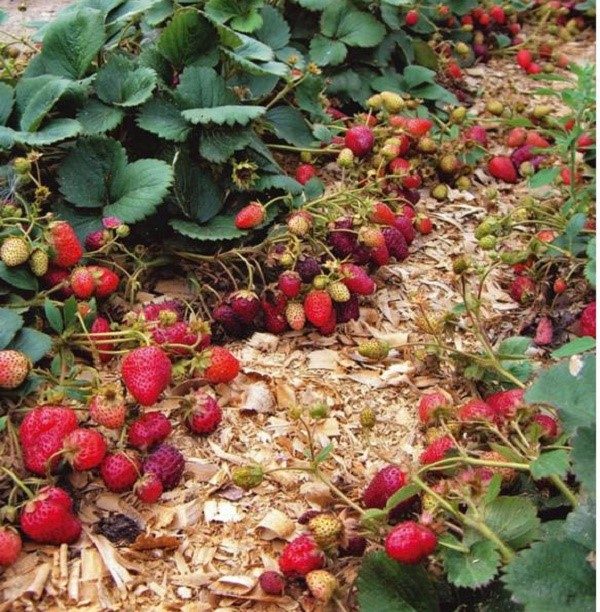

Mulching with wood chips
As you can see, there were many important nuances. The rest of the points that relate to planting should be taken into account based on which variety of remontant strawberries you have chosen for planting. Let's voice the basic rules.
Rule 1. Planting berries should be carried out in well-lit areas, otherwise:
- plants will not be able to gain strength;
- the harvested crop will be small and scanty.
Rule 2. The distance between the bushes should be from 40 to 50 centimeters, between the rows 60 centimeters.
Rule 3. It is best to plant garlic between the bushes, which will protect the strawberries from the attack of slugs.
Watering remontant strawberries
The repairing varieties of garden strawberries need to be watered more often than ordinary garden strawberries, especially during dry seasons. Immediately after planting the seedlings, the plants must be watered every day, then after five to six days, watering can be done every other day, and in the end, watering just a couple of times a month will be enough.
For watering remontant strawberries, you can only use warm water at room temperature, it is great if it is rainwater collected in a barrel painted black. You can water the plantings both in the morning and in the evening chats. When watering, try so that the soil in the area where the remontant garden strawberry grows is moistened from two to three centimeters at a time.
As for the repairing strawberry mulch, as we already wrote above, it is needed, but it is not at all necessary to cover the soil with mulch immediately after watering, this can be done the next day. Instead of mulch, if, for example, it is raining, the soil between the rows can be gently loosened. But remember: it is very important not to damage the roots, which, as we have already written, are located closer to the soil surface than those of common strawberries. The main thing when mulching or loosening is to avoid soil crust so that air can freely penetrate to the roots.
If there is no rain for a long period and the soil dries up, then you can break all the watering rules and moisten the soil almost every day, not allowing the soil to dry out too much, this is very important. If the soil is already very dry, for example, in a country house where you have not been for several days, then first very carefully loosen the soil, and then water it, but do not do the opposite. Frequent watering is especially important for varieties of remontant strawberries with neutral daylight hours; why, I think that there is no need to explain here. These same varieties require more frequent and thorough weeding, especially after rain and the removal of dying leaves that turn red.
Preparatory work in the fall
For remontant strawberries, a few winter months are a real challenge, especially if the winter is not very snowy. It is necessary in the fall to properly carry out all the work on preparing the berry culture for winter so that the strawberry rosettes do not freeze. Strawberries should meet winter with a sufficiently increased green mass. It will protect the buds of the plant from frost.
Gardeners need to check every bush. The root collar should not stick out of the ground, you need to sprinkle it with earth. At the end of summer, the land around the bushes is loosened, and then mulching is carried out.
If the winter is snowy, it will reliably cover all the bushes. But what if there is no snow at all? In this case, leaves or hay will become a shelter. Such materials will save the culture from frost, but they are not entirely convenient, they get wet from moisture, in the spring it is very difficult to clean the strawberry rosettes from them.
You may be interested in: Planting strawberries in spring: is it possible to harvest
With frequent thaws and high humidity, the bushes can dry out. Another drawback is that mice like to hibernate under straw, they can damage the roots.
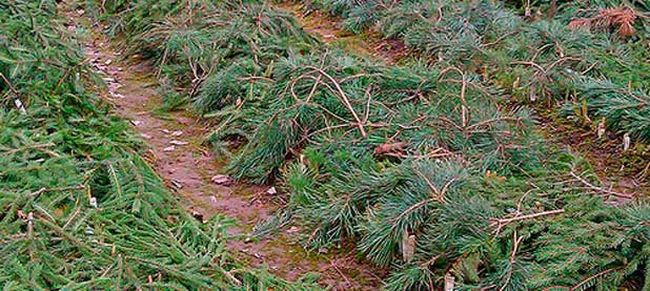

Fertilizing remontant strawberries
It is clear that remontant garden strawberries are very depleted and they definitely need proper feeding. The most actively remontant garden strawberry consumes elements such as nitrogen and potassium from the soil. But she needs phosphorus, but to a small extent. Considering this, fertilizing with phosphorus can be carried out only once, introducing doses of superphosphate (15-20 g per square meter) only when laying a plantation of remontant garden strawberries.
An approximate feeding scheme for remontant strawberries is as follows:
Usually, the first feeding of remontant strawberries is carried out in the third decade of May, during this period urea is used, the composition is very weak - one gram or two (if the soil is poor, per bucket of water), this is the norm per square meter of soil. Around the second half of June, when the peduncles of re-fruiting begin to actively form, you can add mullein (1: 10 - in the amount of 0.5 liters per square meter or bird droppings 1: 15 - in the amount of 0.3 liters per square meter). Along with organic fertilizers, it is quite acceptable to use new-fashioned mineral fertilizers, such as Kristallin Solution or Kemira Lux.
In general, ideally, the entire season should be stretched so that there are about ten fertilizers, alternating these fertilizers.
The second option for feeding remontant strawberries is when, at the very beginning of June, the plants are fed not only with slurry diluted 10 times and bird droppings 15 times, but also with the addition of 1% urea (1 g per bucket of water) to this composition, all this composition should be used up on 2 - 3 square meters of the site.
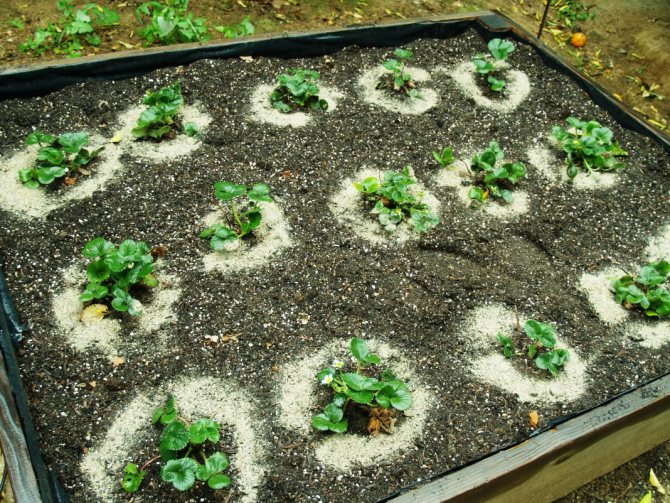

Fertilizer for remontant strawberries. <>
Pruning strawberries in autumn
Disputes on the topic of pruning - mowing garden strawberries or cutting selectively - are less and less heard. The first method has fans. Mow the bushes after fruiting, trying not to hurt the heart. Otherwise, the bush will wither. But most lovers of fragrant delicacies approach each bush individually with a pruner.
Ordinary strawberries of common varieties finish yielding by mid to late July. Then the time comes when you need to start preparing strawberries for winter, no matter how early it may seem.
The purpose of this trim is:
- remove all peduncles;
- cut off old (brownish, stained, broken, dried) leaves;
- cut the mustache (if the task is not to propagate the berry this season).
Minimal pruning is required for young plantings. If the berry bushes are planted in the current season, the leaves are not touched, but the mustache is shortened. Experienced summer residents recommend cutting them not at the root - leaving from 5 to 8 cm.This applies to any variety and age of the plant.
As a result, small bushes with juicy green leaves remain in the garden.New shoots will appear again from the hearts. Strawberries will grow until the cold weather, gain strength, get stronger.
Important! Remove all shoots and leaves completely only from those bushes where infection is noticed. On plant debris, in leaf axils, fungal spores or bacteria overwinter safely. And in the spring they will continue to kill strawberries. Therefore, after removing all the greens, such plants are treated with insecticides, and if mites are found, then with acaricides. So the pests will have no chance of successful wintering and subsequent harmful activity. But no matter how cardinal the autumn haircut is, the heart cannot be injured.
Pruning stimulates vigorous growth. Mustache stretches, leaf plates unfold. What to do with overgrown strawberries in September, when the cold is just around the corner? Cut again. But not so radically. Autumn pruning is the removal of whiskers and leaves lying on the ground. Such a selective haircut will not cause stress, but will allow the berry plantings, after the winter, to recover faster from the frost.
But this procedure is carried out not casually, but thoroughly and accurately. With sharp scissors or pruning shears, cut off unnecessary shoots so as not to catch young leaves, not to damage the delicate greens in the heart.
Garden strawberries of the remontant species are highly demanding, the frost resistance of many varieties is lower than that of the usual one. Therefore, a radical haircut is not carried out so as not to cause unnecessary stress in the plant before wintering. In remontant strawberries, only peduncles, old withered leaves, are cut off to the very shelter. Healthy strong greens are not touched.
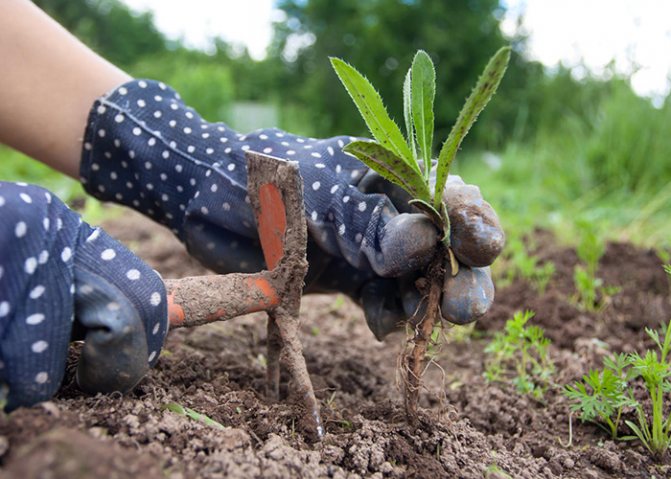

Diseases of remontant strawberries
Gray rot
Garden strawberries are often attacked by gray rot. It manifests itself most actively in thickened plantations, where soil loosening is not carried out and where frequent watering is carried out, especially by sprinkling and cold water. All aerial plant organs can be affected by gray rot, which will lead to losses of up to 85% of the total crop. In order to prevent the appearance of gray rot on remontant strawberries, it is necessary to plant on the site in accordance with the characteristics of the growth and development of a particular variety, to mulch the soil, as well as sufficient, but not excessive watering. At the first sign of infection, the affected plant parts should be removed.
As a preventive measure, plants can be treated at the very beginning of the growing season with 2.0% Bordeaux liquid, and after harvesting at the very end of the growing season, to consolidate the result, with a 1% solution of colloidal sulfur.
There are also fungicides to fight the disease, but you can only use approved ones, in full accordance with the instructions on the package, for example, Strobi, Switch, Euparen, Triadimefon (Bayleton), Kaptan. Biological product Alirin-B is considered the safest from the list of recommended ones.
Brown spot
It manifests itself when, as in the previous case, the strawberry plantations are thickened, there is too much moisture, and the day and night temperatures jump noticeably. As a preventive measure in the spring, remove all dry leaves so that the infection does not "settle" on them and treat with 2% Bordeaux liquid. Do not forget about mulching, which will not allow the fungus to get to the surface.
If the disease is very active, then use approved fungicides, strictly following the instructions on the package, for example, Skor, Strobi, Fundazol.
Powdery mildew
The first sign of the appearance of this disease is the purple color of the strawberry leaf blades, then they curl and turn ash gray, as if sprinkled with old flour. If you do not want this disease to come to visit you, then in early spring treat the plants with a weak (slightly pink) solution of potassium permanganate or 1% colloidal sulfur.
There are also fungicides, but use only approved ones and exactly in accordance with the instructions on the package, for example, Topaz, Fundazol, Tilt, Strobi and Fitosporin-M.
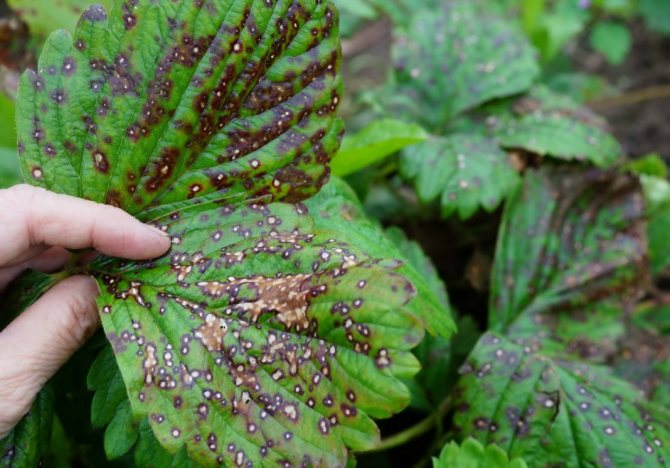

Brown spot on strawberry leaves. <>
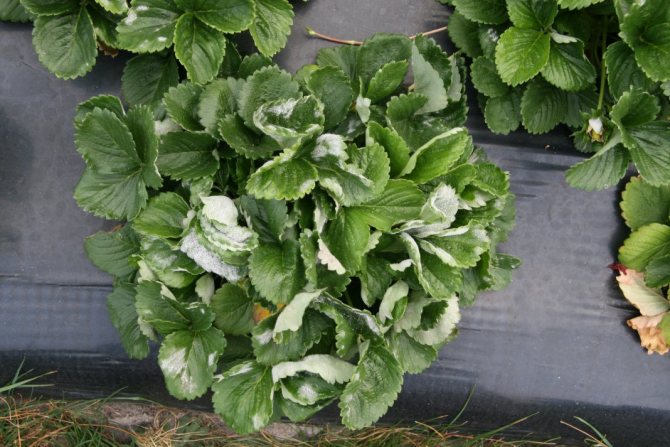

Powdery mildew on strawberry leaves. <>
Care for strawberries after mowing
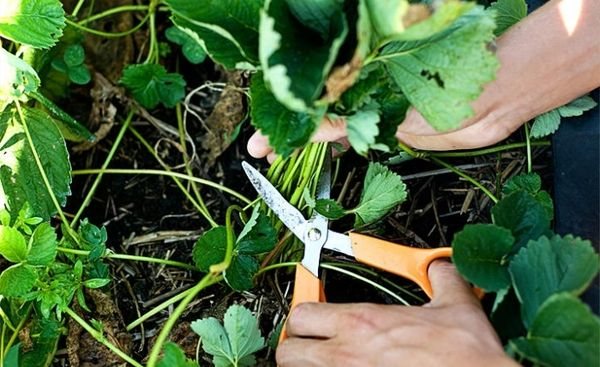

One of the methods of rejuvenation aimed at increasing yields is the complete removal of the leaves that have worked out their resource.
Moreover, some gardeners practice total mowing not only of leaves, but also of the entire aerial part of the plant.
Naturally, such pruning should be carried out only after the end of fruiting and harvesting. For early and mid-early strawberry varieties, this will become possible at the end of July, for other early maturing varieties - no earlier than mid-August. These dates are given for central Russia (Moscow region, etc.) and are indicative. For other regions (Ural, Siberia, Belarus, southern regions, Ukraine, etc.), they may differ in one direction or another from those given.
Repairing strawberry pests
The first pests of remontant strawberries on my site are slugs. I escaped from them by planting garlic between the rows: honestly, I never saw a single slug.
Strawberry mite
It is considered a much more dangerous pest of strawberries: if it damages young leaves, then they rather actively curl and turn yellow. The plant itself is sharply inhibited in growth. A tick can infect from half to the entire plantation, and without treatments, it can lead to its death.
A 3% solution of colloidal sulfur helps to overcome the tick, only it can be used very early in the spring and after the entire harvest has been collected. Well, and of course, all sorts of permitted acaricides.
Strawberry nematode
Usually, if a strawberry is infected with a nematode, then its leaves are deformed and curled. A characteristic feature can be seen on the petioles: they become too fragile and sometimes even break from the wind. Fruiting on such plants is either weak or absent altogether. The nematode is considered a quarantine pest, if it is present on the site, the plants are subject to immediate removal and burning.
Spider mite
Usually, strawberry leaves become as if sluggish, and if you turn them over, you can see traces of the tick's activity - a cobweb. As a result, the leaf blades turn yellow and dry out ahead of time. Gardeners write that Karbofos helps very well against spider mites. After harvesting the entire crop, they process the plants and cover them with foil for several days.
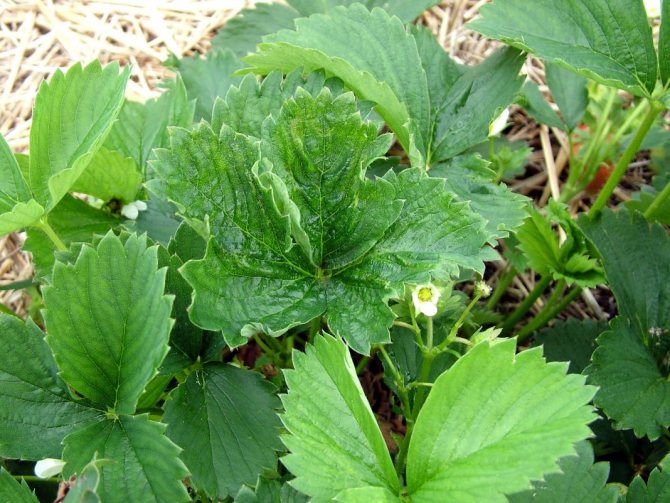

Signs of damage to strawberries with strawberry, or cyclamen mites.
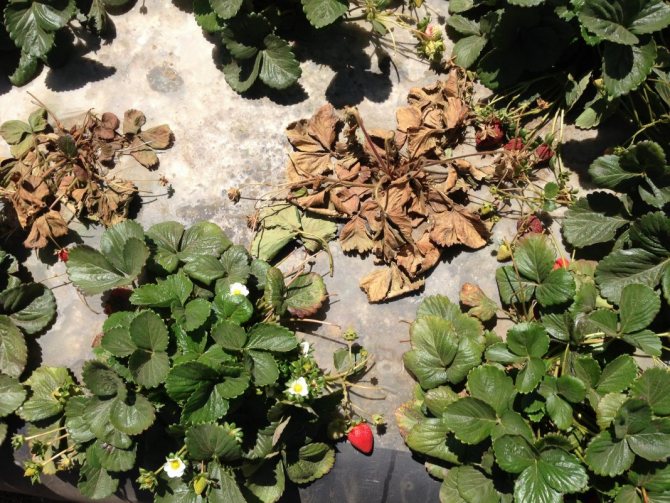

Dead strawberry plants affected by strawberry nematode.
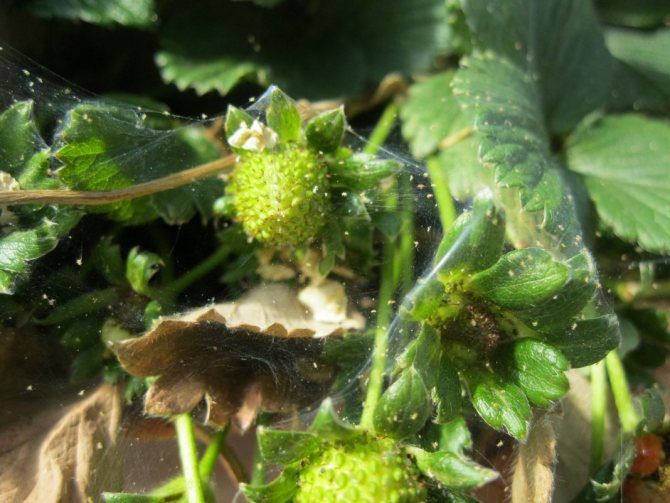

Spider mite infested strawberries.
Growing strawberries on a trellis
Another option for agricultural techniques for remontant strawberries is placing them on a trellis. It can be built near a gazebo, along a path or hedge, near a gazebo, etc. As a trellis, the author suggests using a decorative polypropylene mesh, which can be easily purchased at any building materials store. This net is quite strong, has cells measuring 10 x 10 or 10 x 15 cm, is easy to cut into pieces of any length, the net is well stretched, easily attached in places convenient for growing crops.
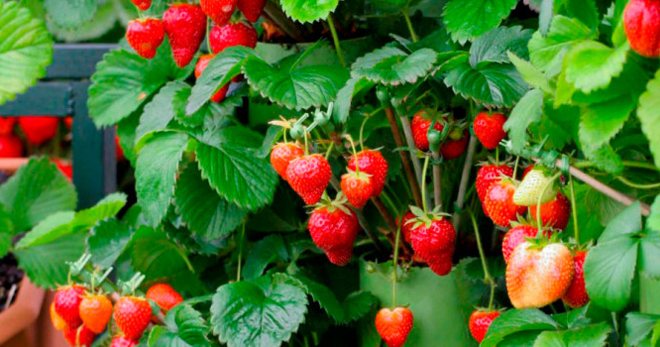

Before planting, you need to dig a trench about 40 cm deep, fill it with humus and complex fertilizers. It is better to plant strawberries every 50 cm along the trellis row. The mustache of young plants must be fixed on the trellis, leaving 5-6 mustache and 4-5 rosettes on each, after the formation of which the mustache is pinched. Usually the mustache is raised on the trellis after the first rosettes bloom. In the fall, one rosette is rooted between the old plants along the row. The next year, their mustache is used to fasten it to the trellis.
Plants planted in the previous year are left to bear fruit until autumn, and then new rosettes are rooted in their place. For normal growth and fruiting of remontant strawberries on a trellis, regular watering and feeding with special fertilizers for the care of strawberries are required.
But strawberries are a sensitive crop, both to an excess and a lack of mineral and organic fertilizers. The disadvantage is easy to eliminate even by visual inspection, the situation is worse with the excess. These are nitrates and the ability of an excess amount of mineral nutrients to inhibit the culture, slow down growth, and promote vegetative growth to the detriment of fruiting.
When growing and caring for remontant strawberries, it is recommended to approach the application rates with caution and monitor the condition of the plants at least by the "eye". For top dressing, special fertilizers are used for fruit and berry crops, based on humic acids with vitamins and microelements (Good power, etc.). Fruiting of remontant strawberries on a trellis begins a few days earlier in comparison with the same strawberries grown in the usual way in the ground, and continues until the onset of frost.
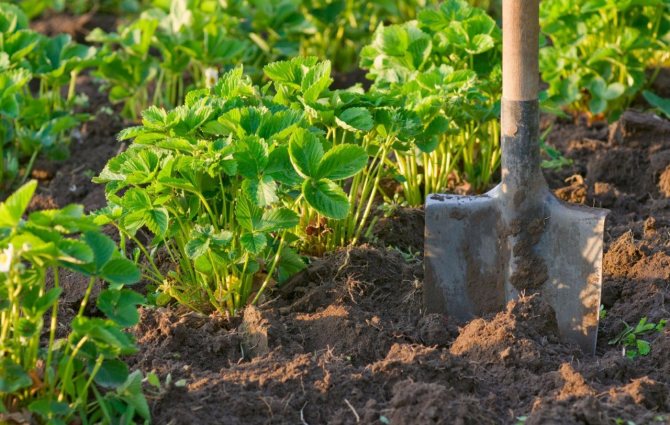

In recent years, the summer period in the southern region has been characterized by droughts, which negatively affects the quantity and quality of berries. In strawberries grown on a trellis, the berries acquire the best taste, excellent presentation, are less sick with gray rot, do not become polluted by the ground during rain or watering. Watering strawberries on a trellis is carried out regularly in small refreshing doses in the morning, immediately after the harvest.
It is recommended to use the tapestry in one place for no more than 5 years. Then it is necessary to do fruit change, land reclamation with the help of high doses of green manure (green) fertilizers, regularly sowing them and burying them in the ground at the budding stage.
Pruning remontant strawberries
Caring for remontant strawberry bushes, among other things, also includes pruning. Usually, it is enough to trim the bushes once a season - either in the spring or in the fall.
If you live in a cold region where remontant strawberries require shelter, then pruning should be done in autumn. This is done as follows: after the final harvest of the entire crop, the lower leaf blades are removed from the bush, trying not to touch the upper leaf blades, because it is in their sinuses that fruit buds are laid, from which fruits will form in the next season.
In the event that berries are not formed on the mustache at all and the gardener does not plan to propagate the remontant garden strawberries in this way, then the removal of the mustache is mandatory.
Remember, however, this rule: after the first fruiting of remontant garden strawberries, whiskers are usually not removed, but leaves that have begun to dry out, formed spots or hide more developed and healthy leaves, must be removed without fail. Removal of such leaves can be carried out in the fall, immediately after harvesting the entire crop, when the foliage slowly begins to dry out.
If you are a resident of a cold region, then take your time and transfer this operation to the spring, remove such leaves after the snow cover has completely melted.
Important! Many neglect the pruning of dead leaves and whiskers of remontant garden strawberries, however, their removal as a shield that protects plants from pathogens, because it is on sick, old foliage that the infection hibernates.
Let's summarize
The care procedures carried out in the fall are caused by many factors, for example:
- will the strawberry bushes survive the winter;
- will they yield a harvest;
- will the berry be large;
- how plentiful will be the collection of fruits, etc.
Read also: Sooty fungus on indoor plants
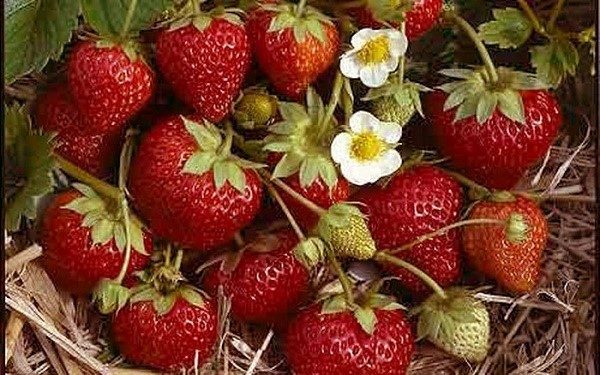

Autumn berry care provides a high yield of the growing season
Do not be lazy and buy enough manure and mineral fertilizers. Even if you move your strawberry beds year after year, fertilizing the soil will benefit other crops as well.
As for the collection of mulch, it can be carried out directly on your site, or you can purchase straw from the farmers harvesting it. The price of such an autumn preparation is not high, but you will have to work hard. However, all your efforts will pay off when harvesting.
Video - Repairing strawberries
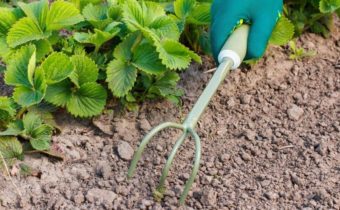

One of the most delicious and healthy berries growing in our country is strawberry (garden strawberry). There is even a saying: "In the house where they eat strawberries, the doctor has nothing to do." Let's talk about caring for strawberries in the fall, preparing for winter.
There are many varieties of strawberries, of which two plant varieties have fundamental differences:
- remontant varieties such as Albion, Koroleva, San Andreas, etc.,
- traditional varieties.
The latter are divided into early ripening (Alba, Clery, Olbia, etc.), mid-ripening (Arosa, Tsaritsa, Asia, etc.) and late (Malvina, Pegasus, Bounty, etc.). The main difference between these varieties is the fruiting process.
Let's start our consideration of these rules of care with the traditional varieties.
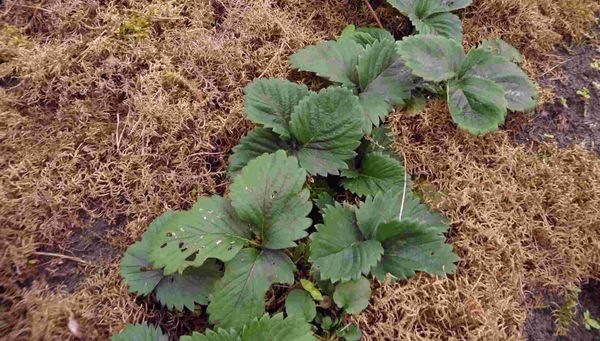

Autumn care and preparation for wintering
Plants of remontant strawberries on a long sunny day often do not fully mature by the end of the season, especially if they are not grown in a greenhouse. Considering this, not only part of the harvest is lost, but sometimes plants that do not have time to adapt to cold snap and frost also suffer. The best option to save such plants is to cover them with fresh straw 5-8 cm thick, and throw spruce branches on top, which will keep the straw from scattering throughout the site.
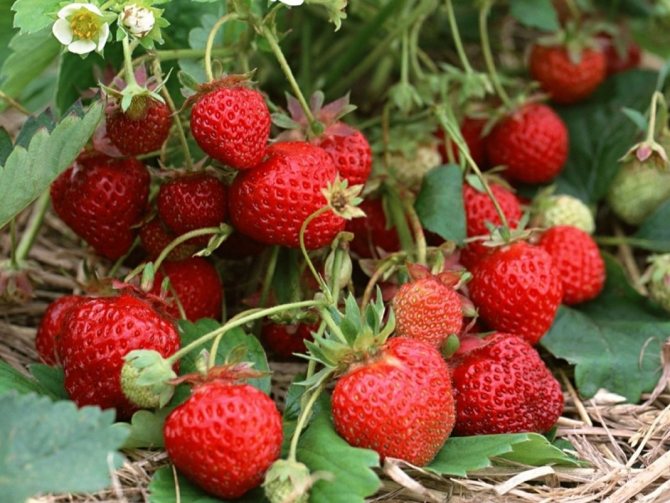

Garden strawberry repairing. <>
How and when to trim
Autumn pruning
Many gardeners postpone strawberry pruning until fall. During this period, there are fewer things in the garden, and finally there is an opportunity to take up a strawberry bed. But by this time, a neglected berry plant usually begins to mope and presents a dull picture. The surface of the soil under the bushes is covered with dried leaves, many living leaves are no longer green, but variegated - with pink, brown or white spots (depending on the disease that painted them). The landscape is completed by protruding dry flower stalks. I just want to quickly put things in order and beauty in the garden, cutting off each leaf outlet at the base!
By autumn, the number of leaves affected by diseases increases sharply.
Do not hurry! Such a radical pruning, carried out in the fall, will cause severe damage to plants, endangering not only the health, but also the life of the bushes. This culture is winter green. It does not shed its foliage in the fall, as many berries do, but renews its leaves gradually throughout the year.
In the autumn period, reserve substances accumulate in green leaves, thanks to which plant tissues do not freeze in winter. In addition, in cold weather, foliage protects horns and flower buds, traps snow and insulates them. By removing the entire leaf outlet in the fall, you will greatly weaken the bushes in anticipation of frost and leave the hearts at the mercy of winter adversity.
In autumn, remove only dry and damaged leaves, and be sure to leave healthy ones.
If you nevertheless decide to carry out the autumn pruning, remove only dried leaves and flower stalks, and be sure to leave the green leaves. If signs of disease are visible, prune the severely affected specimens and then liberally moisten the leaves behind with a solution of a suitable fungicide. Be sure to remove all plant residues from the garden and burn.
Spring pruning
With the arrival of spring warming, overwintered green foliage will be the first to start the process of photosynthesis, which will become the key to the active development of a new leaf apparatus and the formation of a generous harvest. Therefore, cutting off the green leaves of strawberries in the spring is to ruin the future harvest. Plants will direct all their strength to build up new foliage, but they will no longer have the strength to form an ovary.
After the snow melts, you need to remove all dead leaves from the garden
However, in early spring after the snow melts, you should definitely carry out corrective pruning: remove frozen, damaged leaves with signs of disease - they can become a source of infection spread throughout the strawberry plantation.After such a procedure, a therapeutic (or prophylactic) treatment of plants with a fungicide solution is carried out, and all the trimmed foliage is burned.
Summer pruning
Until the moment of harvest, the most important processes will take place in the leaves of the strawberry, on which the size and quality of the berries directly depends. Therefore, in the spring and in the first half of summer, you must help the outlets stay lush and healthy with the help of timely watering, top dressing and preventive spraying from diseases and pests. You can read about how to fertilize this crop in the publication of our website 5 dressings for garden strawberries - and you are guaranteed a harvest.
Cardinal pruning of bushes is carried out immediately after harvest
But when you remove the last berries from the bushes, the most favorable time for a rejuvenating haircut will come. Bushes that have spent all their strength on fruiting, it becomes difficult to maintain such a lush leaf apparatus. Therefore, a cardinal pruning will help them gather their courage, rest, and then do an equally important thing - laying flower buds for the next season. At the same time, new young leaves will grow, which by autumn will turn into lush rosettes and become the key to a safe wintering of plants.

